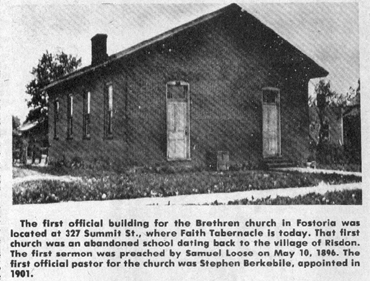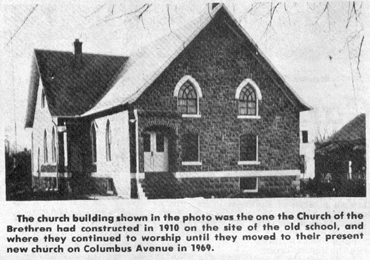October 13, 1983


Picture #1 – The first official building for the Brethren church in Fostoria was located at 327 Summit St., where Faith Tabernacle is today. That first church was an abandoned school dating back to the village of Risdon. The first sermon was preached by Samuel Loose on May 10, 1896. The first official pastor for the church as Stephen Bekebile, appointed in 1901.
Picture #2 – The church building shown in the photo was the one the Church of the Brethren had constructed in 1910 on the site of the old school, and where they continued to worship until they moved to their present new church on Columbus Avenue in 1969.
Picture #3 – Where first Brethren came from in Germany.
Picture #4 – Where Brethren first settled in America.
People the world over have guarded their religious beliefs tenaciously and have suffered severely in many ways to gain and keep religious liberty.
It was the granting of freedom of worship by our founding fathers that drew many immigrants in this country in its early history, and The Brethren, from Germany, were among them.
Today’s article, another long overdue report on local churches, is the story about The Brethren as they were originally called, and some of the interesting historical events, which are part of the story of the church as it is known today…Church of the Brethren.
The year was 1708 in Schwarzenau, Germany, a village located in the Eder Valley, north of Frankfurt. A group of people had assembled in the home of Alexander Mack, to talk about and consider their religious beliefs.
EARLY BRETHREN
At that time in Germany, everyone had to belong to the church to which the ruler of that state belonged. Only three churches were allowed in all of Germany: the Roman Catholic, the Lutheran, and the Reformed or Presbyterian. Those churches all baptized babies. The group that had med to discuss their religious beliefs believed that everyone should decide for himself when he would become a Christian. Those with that latter belief were call Anabaptists, and in some parts of Germany they were often driven from their homes, imprisoned or even killed.
The assembly group believed that people should read their Bibles and pray, and that they should do only those things which the New Testament directed. “We should worship God with the right spirit. The form or the way is not important. A new spirit will be in our worship. We shall find ways of helping others. We shall be Brethren,” they said.
FIRST CHURCH 1708 IN GERMANY
Counting the cost, they had given their solemn word to God and to each other in prayer. With courage in their hearts they left the Mack home and went silently down the winding path to the little Eder River where all were baptized.
The Brethren had started their church…it was 1708. Word of the new church spread and soon there was other congregations organized in German villages in that area. But it wasn’t long until political pressure was exerted by their enemies including harsh treatment, even imprisonment.
They heard about America and that land was free. There they could worship as they pleased. That’s where they decided to go. In 1719 a number of families emigrated to America under the leadership of Peter Becker, settling in the vicinity of Philadelphia, near Germantown, and staying with Mennonite families already there.
In 1723 the Germantown Brethren organized their church, had their first Love Feast, and baptism took place on Christmas day in the Wissahiakon Creek. Because of those events, the Germantown Church of the Brethren is considered the “Mother Church” in America.
THAT FIRST LOVE FEAST
“It was evening and the candles were lighted. All twenty-three members of that early church in America gathered around the long table at John Gomorry’s home. It was near the Wissahiakon Creek. The men sat on one side of the table and the women on the other.
“They sang a hymn and began to wash each other’s feet. They did it because Jesus had told His disciples to do it. ‘If I then, your Lord and Teacher, have washed your feet, you also ought to wash one another’s feet. I have set you an example: you are to do as I have done for you.’ (John 13:14,15,16)”
“Soon this part of the service was over. A simple meal was eaten showing that they all loved one another. They were all brethren.
“When the meal wa finished the communion bread and the communion cup were passed. This reminded them that Jesus had given His body and His blood to help people to know and to love God. The 23 members of the new church resolved to live as brethren should. Then they sang a hymn in German and went out to their homes.
“That Christmas day, 1723, would be remembered as long as there was a Church of the Brethren.”
The service of those Brethren folk on that Christmas day is still repeated in Churches of the Brethren today at Easter and Christmas.
In the early days of the church in Fostoria, prior to the time when they had a baptistery built in the church, baptisms took place in the quarry on Countyline Street or in the creek close by if the candidate preferred.
The present church building on Columbus Avenue has a baptistery, as did the previous church on Summit Street.
OTHERS CAME TO AMERICA
Two other groups of Brethren came to America, one in 1729, under the leadership of Alexander Mack, and another in 1735, leaving virtually no active members in Europe.
Through evangelism and family growth the Brethren spread through Virginia, Pennsylvania and Maryland. Then they moved down the Ohio River by flatboats and across the land in covered wagons into Ohio, Indiana, Kentucky, Illinois and on into the far west.
Many interesting tales about the experiences of those pioneer Brethren as they moved west are told in a book, “The Story of the Brethren,” by Virginia S. Fisher. The book was published in 1957 by the Church of the Brethren. Tales about clearing trails and building roads are told. It explains how they built their homes and then moved on farther west to build still others. It explains how they built their own rafts to move their possessions down the waterways, burying loved ones as they died along the way and how they lived from the land. A book both historical as well as the story of the Brethren, it is well worth reading.
BRETHREN HERE IN EARLY DAYS
There were already some Brethren in and near the village of Rome in the early 1800s, prior to it merging with Risdon to become Fostoria. A Brethren church, called the Rome Church, was located about one mile north of West Independence. In 1893, Sister Dianna Newhouse, who was a member and resided in Fostoria, re- quested that meetings be established in Fostoria on a regular schedule. Later she established a girls Sunday School class and sewing project.
In 1896, the District Mission Board of the Brethren Church established a Mission Point at Fostoria, with the old abandoned school house on Summit Street secured for the meetings. Samuel Loose preached the first sermon there on May 10, 1896. There followed the appointment of Addie S. Kaylor and Anna Raffensperger as missionaries in Fostoria.
Stephen P. Berkebile came as pastor in 1901, continuing until 1904, at which time he and his wife went to India as missionaries. Other pastors who have served the local church are listed separately in this article.
In 1911, The Church of the Brethren built a new church on the same site where the old school had been, which first served as their church.
On June 22, 1969, dedication services were held for a new church on Columbus Avenue built to better serve the congregation’s present and future needs. Dr. Robert Byerly, who was brought up in the local church and whose family had been active in it all their lives, gave the dedication address.
Bruce E. Bennett was pastor of the new church when it was built and dedicated. Three other pastors followed Bennett (1965-71); Pastor Emory Smith (1971-75); Pastor Jim Mitchel (1975-80); with Pastor William Baum arriving in 1980 and still in charge. (Continued next weekend.)
MINISTERS WHO HAVE SERVED BRETHREN CHURCH
Stephen Berkebile 1901-1904
Ira Long 1904-1906
G.A. Snider 1906-1910
William Hamilton 1912-1914
S.P. Early 1914-1917
C.W. Guthrie 1917-1918
E.E. Eshelman 1918-1920
O. Warslter 1920-1923
F. Fair 1923-1924
F.W. Gibson 1924-1925
J.K. Eikenberry 1926-1932
Walter Swihart 1932-1937
R. Boomershine 1937-1944
Oliver Royer 1945-1956
Paul B. Haworth 1956-1965
Bruce E. Bennett 1965-1971
Emory Smith 1971-1975
Jim Mitchel 1975-1980
William Baum 1980-